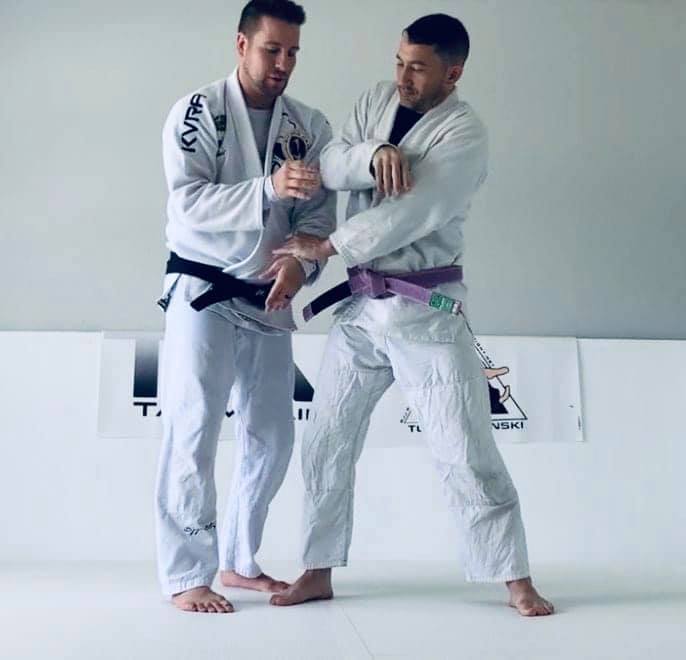2˚ Degree Black Belt Instructor Leveling Up

This is how you level up to 2 Degree Black Belt in Gunji Taiho Jutsu (GTJ). Congratulations to Micheal James Rosequist on his promotion in Gunji Taiho Jutsu . It was truly a team effort to bring together individuals from different time zones, ensuring the video feed was clear and understandable, and putting in a lot of work before the final evaluation today. Micheal’s understanding and application of the instructions learned from the certified instructor training through Gunji University were excellent. I was most pleased with the results and seeing the concepts and pedagogies in action. Therefore, Micheal earned the Gunji Taiho Jutsu Senior Instructor 2°. Additionally, the Yūdansha is also in order due to is application of the GTJ katas. All in all, I am proud to see Micheal embody and put into application the Gunji Taiho Jutsu system.



If you want to become a certified Black Belt GTJ...
Gunji Taiho Jutsu Releases for the 1st Time Ever Katas for Taiho Jutsu | New Course | New Book
Gunji University is excited to finally announce the release of the Gunji Jutsu Taiho official katas: Ichi-No-Kata & Kaiten-Katame-No-Kata. Currently, students can enroll in the GTJ Kata course and work through a self-paced curriculum of 16 video lessons that break down each form and read through the 200+ textbook Volume 6 - Gunji Taiho Jutsu Official Katas. The Kata course provides an e-book version of the textbook, or students can purchase the physical book through Amazon.com. See the admission link above.
It should be noted that if a Gunji Taiho Jutsu student successfully passes a GJT Kata testing of both Ichi-No-Kata and Kaiten-Katame-No-Katas, as the Tori, these evaluations will meet the requirements to earn a Gunji Taiho Jutsu Yūdansha certification. Yūdansha means one that holds a dan rank. If you have completed all of the student curriculum material and wish to be evaluated by a Gunji Taiho Jutsu instructor online through Gunji University,...
Understanding Nishio's Half-Step Can Lead The Way

Practicing Japanese Martial Arts in Japan for the last two years has allowed me to learn more about Judo, Kendo, and Aikido. Within Aikido, I was first attracted to comprehend the Aikikai style as there are today many different variations of Aikido. The founder of Aikido, Morihei Ueshiba, had many live-in students over the years, and one was Yasuo Kobayashi Sensei, who is today an 8th dan in Aikido. I could write several articles about Kobayashi Sensei because of my unique experiences in this dojo learning the Aikikai style, much about taiho jutsu, the jo staff (aikijo), the bokken (aikiken), and among other disciplines like Japanese calligraphy after classes on Saturdays. During the era of Covid-19, I was not able to travel a lot east into central Tokyo, where Ichiro Shishiya Sensei was teaching; however, this would change in 2022. So for 2021, it was a deep dive into the Aikikai approach to Aikido with Kobayashi Sensei.
(Shoji Nishio practicing Judo in...
Proactive Training versus Reactive Training

"The problem is always going to be when organizations are reactive instead of proactive when it comes to training." - David Dye
(Over 42 Years of Law Enforcement & 50 Years in The Martial Arts)
Last week I had a telephone meeting with David Dye to discuss Gunji Taiho Jutsu (GTJ). I was offered the opportunity to come to Southern California to lead a GTJ seminar at his dojo. Uniquely enough for those of you that do not know who Dye Sensei is; he is one of the biggest contributors to arresting technique and taiho jutsu in this country. He is the founder of Shuyokan Ryu in 1980 that is based on the principles of Aikido and includes techniques from Yoshinkai Aikido, founded by Gozo Shioda, Kodokan Judo, a system of Jujutsu founded by Jigoro Kano, Shotokan Karate, a martial art system of empty hand fighting founded by Gichen Funakoshi and other systems.

The quote that starts off this writing is what David Dye Sensei said...
Please Just Stop Teaching This To Law Enforcement

The Dinosaur Gooseneck Wristlock
You will be surprised how many instructors that teach "Defensive Tactics", "Law Enforcement Tactics" or "Taiho Jutsu" show the front gooseneck wristlock. This type of compression lock is often taught in the context of what is called a come-along strategy. "Use this come-along to move the suspect where you want," is what the instructor will show the group. I am here to let you know that in Gunji Taiho Jutsu (GTJ) and in Gunji University's curriculums we do not teach the front gooseneck come-along compression wristlock.



No students never ask the question to the "Defensive Tactics" instructor, what if the suspect uses his free hand to punch or to control his wrist? The answer is the suspect will in real life punch your face or break up the position with his free hand. This type of goose-neck hand positioning is very old, continues to be taught, and is not effective one-on-one when tested. The front gooseneck is...


